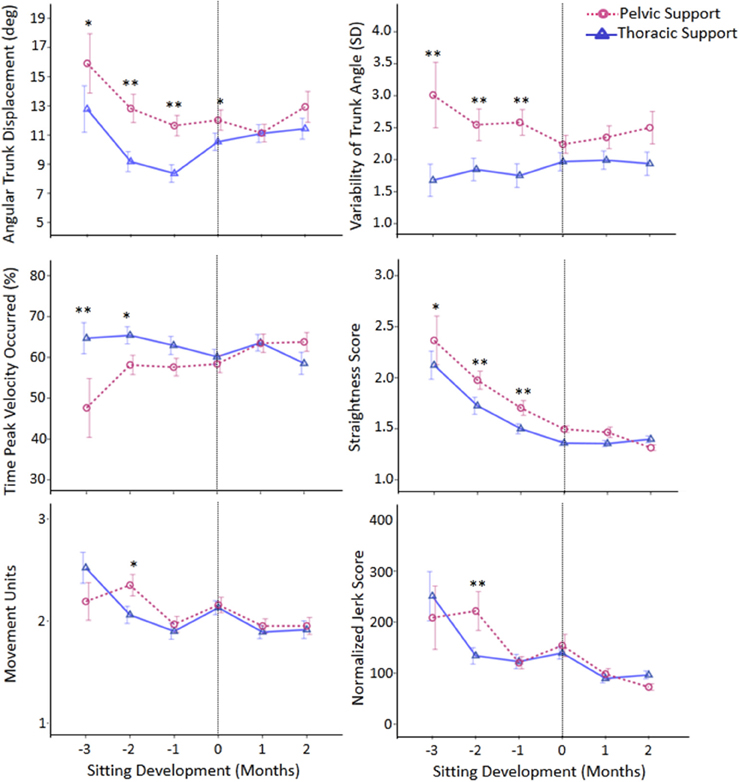The development of trunk control and its relation to reaching in infancy: a longitudinal study
- 1Department of Human Physiology and Institute of Neuroscience, University of Oregon, Eugene, OR, USA
- 2Department of Rehabilitation Sciences, University of Hartford, West Hartford, CT, USA
A corrigendum on
The development of trunk control and its relation to reaching in infancy: a longitudinal study
by Rachwani, J., Santamaria, V., Saavedra, S. L., and Woollacott, M. H. (2015). Front. Hum. Neurosci. 9:94. doi: 10.3389/fnhum.2015.00094
Figure 4 of the article by Rachwani et al. (2015) contained a minor error, which we hereby rectify. In the original figure, the graph displaying the number of movement units across sitting development is incorrect (bottom graph on the left column). We therefore re-submit Figure 4 with the correct graph. We sincerely apologize for the inconvenience.

Figure 4. Estimated means of group data across sitting developmental time. Y-axes display kinematic variables, X-axes display developmental time in months for thoracic (solid line with triangles) versus pelvic (dashed line with circles) support. Vertical dotted line represents time of sitting onset. Error bars, ±1 SE. *p ≤ 0.05, **p < 0.01.
Conflict of Interest Statement
The authors declare that the research was conducted in the absence of any commercial or financial relationships that could be construed as a potential conflict of interest.
Acknowledgments
This work was supported by the National Institutes of Health Grant 1R01HD062745-01, MW, principal investigator, and by the Eugene Evonuk Memorial Graduate Fellowship for JR.
References
Keywords: infant development, independent sitting, posture, trunk control, reaching, EMG
Citation: Rachwani J, Santamaria V, Saavedra SL and Woollacott MH (2015) Corrigendum: The development of trunk control and its relation to reaching in infancy: a longitudinal study. Front. Hum. Neurosci. 9:406. doi: 10.3389/fnhum.2015.00406
Received: 27 June 2015; Accepted: 01 July 2015;
Published: 21 July 2015.
Edited and reviewed by: Gavin Buckingham, Heriot-Watt University, UK
Copyright © 2015 Rachwani, Santamaria, Saavedra and Woollacott. This is an open-access article distributed under the terms of the Creative Commons Attribution License (CC BY). The use, distribution or reproduction in other forums is permitted, provided the original author(s) or licensor are credited and that the original publication in this journal is cited, in accordance with accepted academic practice. No use, distribution or reproduction is permitted which does not comply with these terms.
*Correspondence: Jaya Rachwani, rachwani@uoregon.edu
 Jaya Rachwani
Jaya Rachwani Victor Santamaria
Victor Santamaria Sandra L. Saavedra
Sandra L. Saavedra Marjorie H. Woollacott
Marjorie H. Woollacott